 |
 |
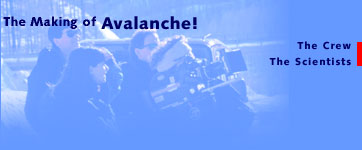
Producers Beth Hoppe and Jack McDonald share their production diary—a rare glimpse into the trials, tribulations, and fun of making a natural disaster film.
Off and Running | Preparing for the Slides
Swiss Snow Science | Fire in the Hole
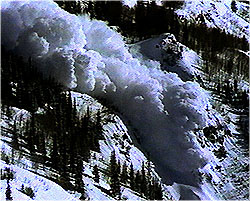 I'm in the middle of researching a film on avalanches, and we aren't planning
to shoot until next winter. But a call comes from a friend in Colorado that a
big storm just won't stop, the highways are closed, and this could be our best
shot at capturing avalanches on film. I run it by my boss, Paula Apsell,
executive producer of NOVA, and we jump into high gear.
I'm in the middle of researching a film on avalanches, and we aren't planning
to shoot until next winter. But a call comes from a friend in Colorado that a
big storm just won't stop, the highways are closed, and this could be our best
shot at capturing avalanches on film. I run it by my boss, Paula Apsell,
executive producer of NOVA, and we jump into high gear.
Brad, the production assistant who has been helping with research, and I get on
the phone. We call the Colorado Avalanche Forecast Center and the Colorado
Dept. of Transportation (CDOT) folks and learn that they are planning to do
avalanche control work—setting off avalanches with explosives in order to
keep them from happening unexpectedly. The good news is they are willing to
let us film the action. The bad news is we have to be there tomorrow.
We arrange to meet Ed Fink of CDOT at the garage at 5 am the next morning. They
are planning to fly the helicopter and do some bombing in the Loveland and
Berthoud Passes and at Mt. Bethel near I-70—areas that have dumped
devastating avalanches in the past. By 4pm we are on a flight to Denver. By
10pm mountain time, we are driving up into the Rockies and the snow.
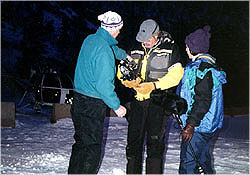 We finally arrive at a motel near the highway garage at about 1:30 am. Sleep is elusive, and 4:30 comes quickly. Brad and I meet up with
the local film crew we've managed to line up at the last minute, and head to
the garage. It is before dawn. The highway crew are already there. They are
dressed in bright orange jump suits. A woman named Candy is pouring explosives
into feed bags while a guy tapes them shut with duct tape. Even though they are
playing with dynamite, they don't seem nearly as nervous or keyed up as I feel.
They are just getting ready for another day of battle in their war against the
snow.
We finally arrive at a motel near the highway garage at about 1:30 am. Sleep is elusive, and 4:30 comes quickly. Brad and I meet up with
the local film crew we've managed to line up at the last minute, and head to
the garage. It is before dawn. The highway crew are already there. They are
dressed in bright orange jump suits. A woman named Candy is pouring explosives
into feed bags while a guy tapes them shut with duct tape. Even though they are
playing with dynamite, they don't seem nearly as nervous or keyed up as I feel.
They are just getting ready for another day of battle in their war against the
snow.
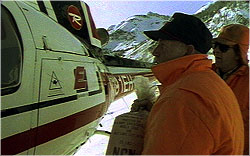 At dawn the helicopter hired by CDOT takes off. Our helicopter hasn't made it
yet, so I jump into an orange truck with one of the highway ground crew, the
film crew following behind, and we rush off to the first bombing location. The
ground trucks are going to close I-70 near Mt. Bethel, sweep the area, and then
the helicopter will move in for the bombing. The plows are standing by if the
road needs to be cleared of snow after the control work. They don't expect an
avalanche to hit the road, but they close it anyway, for safety. We are given
special permission to film from where the highway crew watches, well in front
of where the road is closed.
At dawn the helicopter hired by CDOT takes off. Our helicopter hasn't made it
yet, so I jump into an orange truck with one of the highway ground crew, the
film crew following behind, and we rush off to the first bombing location. The
ground trucks are going to close I-70 near Mt. Bethel, sweep the area, and then
the helicopter will move in for the bombing. The plows are standing by if the
road needs to be cleared of snow after the control work. They don't expect an
avalanche to hit the road, but they close it anyway, for safety. We are given
special permission to film from where the highway crew watches, well in front
of where the road is closed.
The transportation folks are feeling the pressure to keep things moving.
Closing the interstate at 7:30 am affects an awful lot of people. Someone in
the helicopter sees ski tracks in the area. They fly low and are relieved to
see that the tracks are old. The radios crackle with the news that everything
is clear, and then highway supervisor and bombadeer Ed Fink calls "Fire in the
hole!" as the first 20-pound bomb is dropped. We see it fall, and stare at
where it went into the snow. The fuse is 90 seconds long; it feels like 10
minutes.
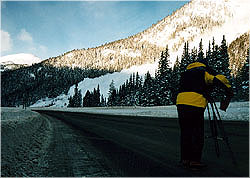 Finally we see a puff of smoke and snow followed by the sound of a muffled
explosion. I see a fracture. It starts slowly at first, but then the whole
mountainside seems to be moving down. It looks like slow motion from my vantage
point. I start to jump up and down. What a thrill! I am looking at my first
huge avalanche. Much to my surprise, it doesn't make any noise. But it tumbles
and builds and tons of snow are moving downhill. Some of the snow reaches all
the way to the road, and we all feel the wind and are dusted with a little of
the powder from the cloud that rises. Everyone is excited. Not just me. The
highway folks love this too. Some were taking pictures. "It ran big!" "Wow, did
you see that?" But they quickly move in to clear the road and get the
interstate open.
Finally we see a puff of smoke and snow followed by the sound of a muffled
explosion. I see a fracture. It starts slowly at first, but then the whole
mountainside seems to be moving down. It looks like slow motion from my vantage
point. I start to jump up and down. What a thrill! I am looking at my first
huge avalanche. Much to my surprise, it doesn't make any noise. But it tumbles
and builds and tons of snow are moving downhill. Some of the snow reaches all
the way to the road, and we all feel the wind and are dusted with a little of
the powder from the cloud that rises. Everyone is excited. Not just me. The
highway folks love this too. Some were taking pictures. "It ran big!" "Wow, did
you see that?" But they quickly move in to clear the road and get the
interstate open.
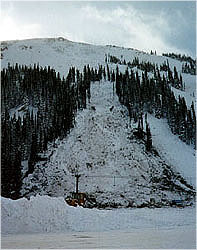 Our helicopter is now in the area, and we arrange to meet it near the exit for
Loveland ski area. The CDOT heli is also putting down there for more bombs. As
soon as we make it to the location, our cameraman heads over to talk to the
pilot. As we stand there, someone points over toward the Loveland Basin ski
area. I look over, and a huge avalanche is coming down, taking enormous trees
and throwing them in the air as it goes. I point and yell to our cameraman, but
he is facing the other way and can't hear me over the helicopter. And then it
is over—too late, unfortunately, to have turned on the camera and captured
it for our program.
Our helicopter is now in the area, and we arrange to meet it near the exit for
Loveland ski area. The CDOT heli is also putting down there for more bombs. As
soon as we make it to the location, our cameraman heads over to talk to the
pilot. As we stand there, someone points over toward the Loveland Basin ski
area. I look over, and a huge avalanche is coming down, taking enormous trees
and throwing them in the air as it goes. I point and yell to our cameraman, but
he is facing the other way and can't hear me over the helicopter. And then it
is over—too late, unfortunately, to have turned on the camera and captured
it for our program.
 We drive over to the ski area to see the damage. It turns out a ski patroller
doing avalanche control work at the ski area tossed a five- pound hand charge
and set off an enormous slide. When it takes out trees like that it, is
creating a new avalanche path. Or maybe not new, but judging from the size of
the trees, one that hasn't run for about a hundred years. For me it is a
graphic demonstration of the power of this remarkable force of nature.
We drive over to the ski area to see the damage. It turns out a ski patroller
doing avalanche control work at the ski area tossed a five- pound hand charge
and set off an enormous slide. When it takes out trees like that it, is
creating a new avalanche path. Or maybe not new, but judging from the size of
the trees, one that hasn't run for about a hundred years. For me it is a
graphic demonstration of the power of this remarkable force of nature.
We spend the rest of the day following CDOT and the forecaster from the
Colorado Avalanche Forecast Center. By the evening, we are exhausted. But we
hear that in the southwest corner of the state, on highway 550 through the San
Juans, another group from CDOT will be bombing tomorrow. And they too have had
a lot of snow. And the forecast is for a crystal clear day. It's a long drive,
about 9 hours, made even longer by the fact that 550 is closed. I'm tired and
feel like crying, but there isn't much time. We have to go for it if we are
going to make it to Silverton to film the action. CDOT needs to get the road
open, and they aren't about to wait for a film crew to show up.
We hit the road, grabbing a couple hours sleep in Ridgeway on the way. When
morning comes it is gorgeous, and we are relieved to hear they are going to
bomb Wolf Creek Pass first. That should give us the time we need to get to
Silverton.
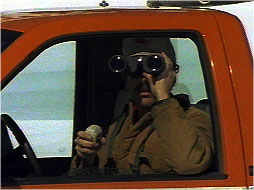 We make it in time, lining up a helicopter as we travel, and head up the closed
portion of 550. Gary King, the highway crew supervisor, takes us to a
spot where we can see several of the slide paths. We set up a second camera on
the ground, and then send the primary camera up to film the action from the
air.
We make it in time, lining up a helicopter as we travel, and head up the closed
portion of 550. Gary King, the highway crew supervisor, takes us to a
spot where we can see several of the slide paths. We set up a second camera on
the ground, and then send the primary camera up to film the action from the
air.
It is another amazing day. I'm at the ground
location watching avalanche after avalanche stream down all around me. I feel
so happy to have one sequence and some avalanches in the can. Now it's time to
head home, finish our research on the science of avalanches, and structure the
story we are going to tell for this NOVA program.
Two days later a call comes from the lab that the first 9 rolls of film -
essentially everything from the first day - were ruined in a freak accident in
the processing. I'm flooded with anger and disappointment, neither of which—I realize when I finally calm down—will bring the lost film back to life. I
just have to take the summer and plan the film and assemble the team we need to
go out next year and capture our story. I can only hope we get another snowy
winter.
Continue: Preparing for the Slides.
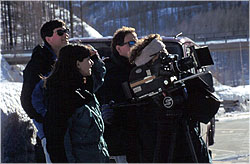
 Beth Hoppe
Beth Hoppe
I'm the producer/director. That means the program is ultimately my
responsibility—when things go well, and when they don't. By the time we go
on the road this winter to film, I will have been researching the topic on and
off for over a year. With the co-producer I have drafted a treatment which
lays out our story and describes exactly what we plan to shoot. We have an
approved budget and schedule. Now we need a good team to execute it. And I
think I've put together one of the best.
 Kate Churchill
Kate Churchill
Associate Producer
Kate is the engine that keeps the machine running. She is my right hand.
Everything falls under her list of responsibilities, from budgets to meals to
schedules to travel arrangements to ordering film to logging tapes to helping
figure out the content to taking care of all of us on the road...It is endless.
She has endless energy. Kate and I are the only NOVA staff on the job. Everyone
else is freelance, hired either by the day, the shoot, or whatever time period
is appropriate.
Jack McDonald
Co-producer, co-writer
Jack is a freelancer who has done a lot of writing for other science and nature
programs. He recently wrote a treatment for a film that we really liked, but
for a variety of reasons that film can't be made right away. This seems like a
good project to work with Jack on. Because I am also NOVA's series producer, I
won't be able to go on every shoot or be in the edit room all the time. He can
fill in when I can't be there. In the process of making a deal, we realize we
know each other - from junior high.
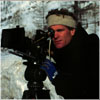 Bob Poole
Bob Poole
Director of Photography
The pictures are up to Bob, a cinematographer who specializes in elephants and
aerials. When I first saw his resume, I didn't realize right away that he was
our guy. But it didn't take long. He is also an energetic and fearless skier,
avalanche aware and interested in the topic, a totally dedicated and committed
professional with a solid reel of footage.
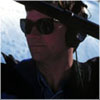 Dave Ruddick
Dave Ruddick
Sound
Pictures are only part of the story. Audio is vital. When you are shooting on
film, the sound is recorded separately on a 1/4" reel to reel or DAT (Digital
Audio Tape) machine. Slates, either a clapper like those you see in Hollywood,
or a bloop slate, are used as a reference point to synchronize the film with
the sound. One person is responsible for getting the sound, getting the slate,
micing all the talent, and making sure we aren't left in the dark ages of the
movies. Dave is perfect for this job. A former ski patroller and EMT, the
risks aren't an issue. He is big, and can ski, even with a 90-pound
(literally) pack of equipment on his back.
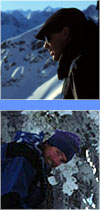 Dave Pickner
Dave Pickner
Kent Harvey
Assistant Camera
This job is to assist the cameraman, and at the top of his
list of responsibilities is changing the film rolls. 16mm film comes from the
manufacturer in 400 foot reels—which works out to about 10 minutes of screen
time per roll—and we always need another film roll at the ready so we don't
miss out on important action. Like still film, it cannot be exposed to
daylight, or it will be ruined. He has to do this all by his sense of touch
only, working in a black bag with two entry holes for his hands. Lenses,
magazines (which hold the loaded film rolls) the tripod, or "sticks" as they
are called, are all the responsibility of the assistant camera person.
 Ed Adams is an Assistant Professor of Civil Engineering at Montana State
University. He received his Ph.D. from MSU in mechanical engineering.
Currently Ed focuses on microstructural changes of snow and morphologic
processes of ice.
Ed Adams is an Assistant Professor of Civil Engineering at Montana State
University. He received his Ph.D. from MSU in mechanical engineering.
Currently Ed focuses on microstructural changes of snow and morphologic
processes of ice.
|
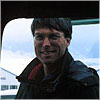 Karl Birkeland is an avalanche specialist with the Gallatin National Forest
Avalanche Center in Bozeman, Montana. He is currently pursuing his
dissertation in physical geography for Arizona State University working on the
effect of terrain on snowpack.
Karl Birkeland is an avalanche specialist with the Gallatin National Forest
Avalanche Center in Bozeman, Montana. He is currently pursuing his
dissertation in physical geography for Arizona State University working on the
effect of terrain on snowpack.
|
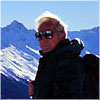 Othmar Buser began working at the Swiss Federal Institute for Snow and Avalanche
Institute in Davos, Switzerland in 1965. His initial studies were focused on
hail research and then his focus changed to avalanche forecasting using
statistical methods and acoustic properties of snow. During his thirty-two
years working at the Institute's location high atop the Weissfluhoch in Davos,
Switzerland, Othmar has taken a lift to work, but skies or hikes home almost
every day.
Othmar Buser began working at the Swiss Federal Institute for Snow and Avalanche
Institute in Davos, Switzerland in 1965. His initial studies were focused on
hail research and then his focus changed to avalanche forecasting using
statistical methods and acoustic properties of snow. During his thirty-two
years working at the Institute's location high atop the Weissfluhoch in Davos,
Switzerland, Othmar has taken a lift to work, but skies or hikes home almost
every day.
|
 Jim Dent is an Associate Professor of Civil Engineering at Montana State
University where he also received his Ph.D.. His research specialty is snow
mechanics and has been studying avalanches in Montana for 20 years.
Jim Dent is an Associate Professor of Civil Engineering at Montana State
University where he also received his Ph.D.. His research specialty is snow
mechanics and has been studying avalanches in Montana for 20 years.
|
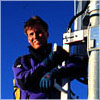 Tom Russi is the Head of the Avalanche Alert Systems Group at the Swiss
Federal Institute of Snow and Avalanche Research. He is in charge of a large project
to put automatic weather and snow stations throughout the Alps, which local
forecasters will be able to access for up-to-the-minute snow and wind data.
Before Tom began working at the Institute he enjoyed a rigorous career as a
climbing and mountaineering guide in Scotland.
Tom Russi is the Head of the Avalanche Alert Systems Group at the Swiss
Federal Institute of Snow and Avalanche Research. He is in charge of a large project
to put automatic weather and snow stations throughout the Alps, which local
forecasters will be able to access for up-to-the-minute snow and wind data.
Before Tom began working at the Institute he enjoyed a rigorous career as a
climbing and mountaineering guide in Scotland.
|
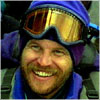 Scott Schmidt is a graduate student at Montana State University in Civil
Engineering, where he has been pursuing his Ph.D. for 12 years. Scott has been
making good use of those years of education by working as a ski patroller for
the Bridger Bowl.
Scott Schmidt is a graduate student at Montana State University in Civil
Engineering, where he has been pursuing his Ph.D. for 12 years. Scott has been
making good use of those years of education by working as a ski patroller for
the Bridger Bowl.
Off and Running | Preparing for the Slides
Swiss Snow Science | Fire in the Hole
Photos: (1), (3), (7), (15), (17-18), (20) WGBH Educational Foundation; (2), (4-6) Brad Puffer/WGBH;
(8), (11-14), (16) Kate Churchill/WGBH; (9), (10), (19) David Ruddick.
Capturing |
Making |
Elements |
Snow Sense |
Resources
Mail |
Teacher's Guide |
Transcript |
Avalanche Home
|
NOVA Home | WGBH Home | PBS Home
Search | Feedback | Shop
© 1997 WGBH
|
|